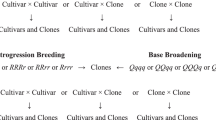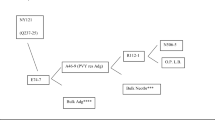Abstract
Variation in resistance to tuber damage by the tobacco flea beetle,Epitrix hirtipennis (Melsheimer) was investigated for progeny from a group of parental clones from the USDA potato breeding program. Each of nine clones, used as males, was crossed with three different clones, and the family responses were measured in field tests (Lubbock, Texas, 1967 and 1968) by counting tuber pits made by the flea beetle larvae.
Statistically significant differences among families were found. The differences were due mainly to the male parents, since the male variance component, σ 2M (0.470±0.235), was larger than the variance component of females mated to the same male, σ 2F(M) (0.080±0.057). Theoretically, each of these components contains one-fourth of the genetic additive variance, and therefore, should be nearly equal if digenic, trigenic, and quadrigenic effects are small (and if no maternal effects are present). Apparently the male and female parents did not, in relation to the frequency of alleles controlling response to the flea beetle, represent the same genetic population.
Heritability on an individual basis, calculated with 4 σ 2M as numerator, equals 0.64±0.36; and at a 10% selection level the genetic advance value predicted for individual selection equals 1.896 SD units. If 100 males were crossed to one female each, and 20 progeny per family tested in 10 replicates, the genetic advance value predicted for selecting the best 10 males on the basis of their family performance equals 0.976 SD units. Thus individual or phenotypic selection appears to be more effective than selection based on half-sib progeny tests.
Resumen
La variación de la resistencia al daño de tuberculos por el pulgónEpitrix hirtipennis (Melsheimer) se investigó en la progenie de clones del Programa de Mejoramiento de Papa del Depaartmento de Agricultura de los Estados Unidos (USDA).
Cada uno de los nueve clones utilizados como padres, se cruzaron con tres clones diferentes y la respuesta de las familias se midieron en ensayos de campo (Lubbock, Texas 1967 y 1968) contando los huequitos de los tubérculos (tuber pits) hechos por las larvas del pulgon.
Se encontro diferencias estadisticamente significativas entre familias. Las diferencias se debieron principalmente a los padres masculinos porque el componente de variancia masculina σ 2M (0.470±0.235), fue mayor que el componente de variancia de los padres femeninos cruzados con el mismo macho, σ 2F(M) (0.080±0.057). Teóricamente, cada uno de estos componentes contiene un cuarto de la variancia genetica aditiva, por eso, los componentes deben ser casi igual si los efectos digénicos, trigénicos, y quadrigénicos, son pequeños (y si los efectos maternales no estan presentes). Aparentemante los padres masculinos y femeninos, en relacion a la frecuencia de alelos que controlan la reacción al pulgón, no representaron la misma poblacion genetica.
Heredabilidad en base individual, calculado con 4 σ 2M como numerador, es igual a 0.64±0.36; y a un nivel de seleccion de 10% el valor del avance genético pronosticado para seleccion individual es igual a 1.896 SD unidades. Si cada uno de 100 machos fueran cruzados con una hembra, y si 20 individuos per familia fueran ensayados en 10 replicaciones, el valor del avance genético pronosticado para seleccionar los 10 mejores machos en base al comportamiento de sus familas seria igual a 0.976 SD unidades. Por eso, selecion individual o fenotipica parece ser mas efectivo que la selection basada en ensayos de media-sib (half-sib) progenie.
Similar content being viewed by others
Literature Cited
Anderson, L. D. and H. G. Walker. 1936. Control of the potato flea beetle,Eptirix cucumeris (Harris). Bull. 92. Virginia Truck Exp. Sta.
Blodgett, E. C. and A. E. Rich. 1949. Potato diséases, defects, and insect injuries in the Pacific Northwest. Bull. 195. Washington Agricultural Experiment Station.
Comstock, R. E. and H. F. Robinson. 1948. The components of genetic variance in populations of biparental progenies and their use in estimating the average degree of dominance. Biometrics 4: 254–266.
Kempthorne, O. 1955. The correlation between relatives in a simple autotetraploid population. Genetics 40: 168–174.
Sanford, L. L. and J. P. Sleesman. 1970. Genetic variation in a population of tetraploid potatoes: Response to the potato leafhopper and the potato flea beetle. Amer. Potato J. 47: 19–34.
Author information
Authors and Affiliations
Additional information
Cooperative investigations of the Crops Research Division, Agricultural Research Service, U.S. Department of Agriculture, and the Campbell Institute for Agricultural Research, Paris, Texas.
Rights and permissions
About this article
Cite this article
Sanford, L.L., Peel, R.D. Genetic variation in a population of tetraploid potatoes: Tuber resistance to the tobacco flea beetle. American Potato Journal 47, 169–175 (1970). https://doi.org/10.1007/BF02871194
Accepted:
Issue Date:
DOI: https://doi.org/10.1007/BF02871194




